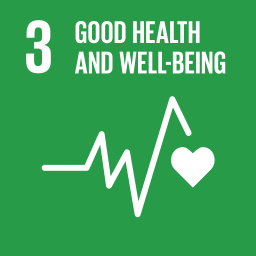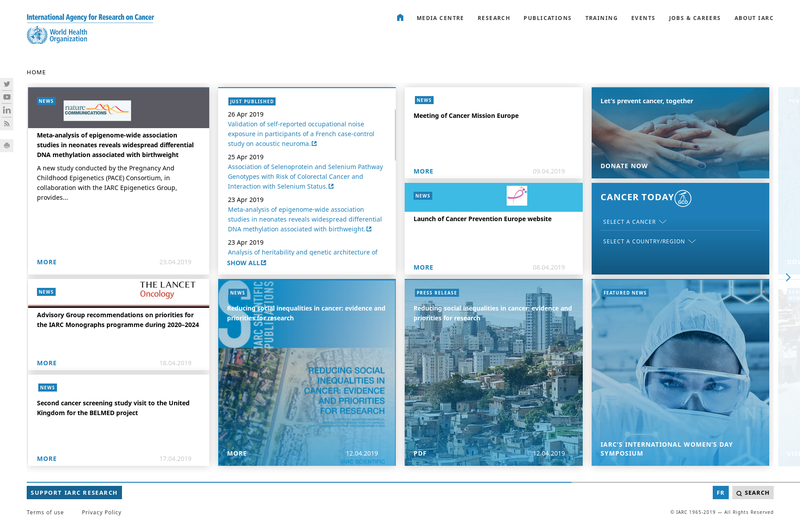Spherical is proud to have helped cancer research worldwide by assisting IARC/WHO in consolidating their web presence.
Why are we doing this?
 IARC is the leading international cancer research agency. Due to various reasons, good and bad, worldwide cancer incidence is
growing and the fight against cancer is becoming the focus of modern medical science, technology and practice.
IARC's mission is not only to advance the research but also to educate the public about cancer risks, inform clinicians about
new methods of treatment and prepare new generations of competent oncologists worldwide. Helping IARC's public communications
is therefore a contribution to SDG 3, Good Health and Well-being.
IARC is the leading international cancer research agency. Due to various reasons, good and bad, worldwide cancer incidence is
growing and the fight against cancer is becoming the focus of modern medical science, technology and practice.
IARC's mission is not only to advance the research but also to educate the public about cancer risks, inform clinicians about
new methods of treatment and prepare new generations of competent oncologists worldwide. Helping IARC's public communications
is therefore a contribution to SDG 3, Good Health and Well-being.
Our task
Our task was to migrate web content and systems developed internally and by external vendors over a long period into
one content management system, to develop and implement a new design for the web presence and to replicate the
functionality of the old systems.

Challenges
IARC's web presence was implemented using static HTML and PHP – tens of thousands of pages overall. The pages followed
basic structure, but local automation, disparate mini-systems and the use of different versions of libraries
made automated migration challenging.
IARC's legacy web presence evolved organically over more than 15 years. Concurrently, the world witnessed
explosive growth of the web, with approaches, frameworks and libraries emerging and dying at an ever-increasing pace.
The agency always tried to stay on top of technological advancements, but it didn't have the resources to update its
entire ever-growing web presence to the latest technology stack. As a result, tens of thousands of pages worth of
web content authored statically or generated using various database systems and technologies accumulated over time.
The agency chose WordPress as their target content management system.
WordPress is a popular content management system that is known for user empowerment. At the same time,
it does not offer easy or consistent interoperability and does offer a rather messy story when
it comes to deeper customization. The latter was required to reimplement some of IARC's
legacy systems and the very futuristic design was created by our partners from JetStyle.
Our technical approach
Manual migration of such a vast amount of content was ruled out immediately; automated migration involved precise
analysis of the page structure used in various sites and sub-sites created by the agency and reverse-engineering of
requirements from the behaviour of legacy database systems found in the web code. We developed a generic
infrastructure layer for migration of web content and a specific interpreter for each particularity found on
the web pages to be migrated.
In order to keep WordPress in check, we implemented a hosting scenario where WordPress, its database (MariaDB)
and the reverse proxy (Nginx) were enclosed in Docker containers. The container set was managed using Docker Compose
and the overall operational environment was set up using GNU Make. Making the WordPress theme a part of
code allowed us to properly version-control its development and isolate user and developer realms.
We used the ACF plugin and its REST API to inject the migrated content into WordPress and preserve its
custom structure where it was necessary for the reimplementation of the legacy database systems.
These systems were reimplemented using ACF and custom post types.
As a result, the client received a WordPress-based system that is much more manageable and operationally
mature than the large majority of WordPress-based systems in the world. The client did not need to migrate
content by hand. The system they received was also easy to replicate for the client's other websites.
Project management
The project was managed according to PRINCE2
methodology with a custom, formally approved tailoring statement. Task management
and project tracking was done in JIRA, code collaboration in GitHub.
Collaboration on design between the client, developers and designers was organised
using Figma.
Spherical has a distributed team and we did not have a physical presence at the client's
location. To facilitate collaboration and team coherence, we set up a constantly
available video meeting room in Zoom and organized regular (weekly) and ad-hoc
meetings with all project stakeholders there. Minutes of meetings were routinely
distributed to project stakeholders and annotated with task tracking links in
JIRA. This allowed us to maintain the focus and constantly keep the finish line
in sight for everyone involved.
Client testimonial
Provision of testimonials to any vendor is against the the client's internal policies.
Contacts for reference checks are available upon request.
![]() IARC is the leading international cancer research agency. Due to various reasons, good and bad, worldwide cancer incidence is
growing and the fight against cancer is becoming the focus of modern medical science, technology and practice.
IARC's mission is not only to advance the research but also to educate the public about cancer risks, inform clinicians about
new methods of treatment and prepare new generations of competent oncologists worldwide. Helping IARC's public communications
is therefore a contribution to SDG 3, Good Health and Well-being.
IARC is the leading international cancer research agency. Due to various reasons, good and bad, worldwide cancer incidence is
growing and the fight against cancer is becoming the focus of modern medical science, technology and practice.
IARC's mission is not only to advance the research but also to educate the public about cancer risks, inform clinicians about
new methods of treatment and prepare new generations of competent oncologists worldwide. Helping IARC's public communications
is therefore a contribution to SDG 3, Good Health and Well-being.
